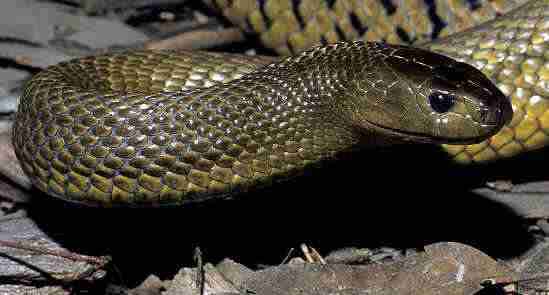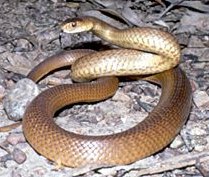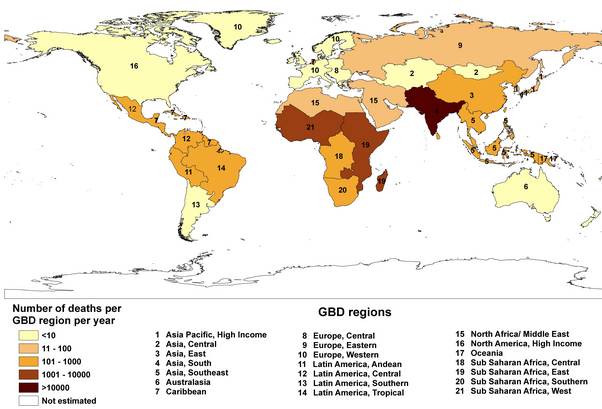Most venomous snake in the world: Found only in Australia

Fierce Snake , Inland Taipan (Oxyuranus microlepidotus)(1)
The Venom deliverd by one bite would be enough to kill over 100 people.
 Select an article on this page.
Select an article on this page.
1: Fierce Snake , (Oxyuranus microlepidotus)
2: Snakebite in Australia.
3: Snakebite Worldwide.
4: Most Venomous Snakes in order by Lethal dose.
5: Other Venomous Australian Creatures.
The 'Top Ten' most poisonous snakes on earth.
The Fierce Snake: The most poisonous snake on earth.
A Snake that is 68 times as poisonous as the King Cobra and 740 times as poisonous as the Western Diamondback Rattlesnake.
The other 9 of the 'Top Ten' most poisonous snakes on earth are also found only in Australia.(2)
The Fierce Snake, otherwise known as the Inland Taipan or Small-Scaled Snake,
can reach an average length of about 2 metres (6.5 ft) with a maximum of about 2.7 m ( 8.8 ft).
The upper surface of the snake can vary from dark brown to a light straw
colour.
Dramatic seasonal colour changes also take place, with a dark winter and
light summer phases.
Distribution
The Inland Taipan lives in the far west and southwest of Queensland, extending through the far west of New South Wales into the northeast corner of South Australia, and into the southeast of the Northern Territory.
 This distribution includes the drainage systems of the Cooper and Diamantina Rivers, as well as the Bulloo, Paroo, Warrego and lower Darling.
Few people live in this remote, hot, dry country, and the Inland Taipan is rarely encountered.
This distribution includes the drainage systems of the Cooper and Diamantina Rivers, as well as the Bulloo, Paroo, Warrego and lower Darling.
Few people live in this remote, hot, dry country, and the Inland Taipan is rarely encountered.
To escape the blistering heat of this open country, the Inland Taipan shelters in abandoned animal burrows, deep fissures in cracked ground, rock crevices and sink holes.
The only Victorian specimens were collected near the junction of the Murray and Darling rivers in 1857. It lives in areas of cracking soils of river overflows, flood plains or on gibber plains.
No fatalities have been attributed to this species, and all known bites have been to people who keep them in captivity or actively seek them out in the wild
Diet
The diet is almost solely composed of small mammals, particularly native rats, which, at times, reach plague proportions in this region. The prey is subdued with a rapid, accurate strike, injecting the extremely toxic venom deep into the prey item. The venom is unequalled in toxicity amongst any snake anywhere in the world.
The Taipan Venom.
The most deadly component is a neurotoxin that immobilises by paralysis. It essentially scrambles the body's communication lines - the nerves that carry electrical signals around the body.
The taipan neurotoxin acts at the point where nerves join to muscles, called the neuro-muscular junction.
The toxin binds to the ends of the nerves, blocking electrical activity and shutting down communication between the brain and muscles.
As the poison spreads the victim experiences headache, nausea, vomiting, pain in the abdomen and dizziness.
Blurred vision follows, sometimes accompanied by convulsions and, in severe cases, coma.
The neurotoxin (like many other snake venoms) is also a myotoxin, meaning it eats away at muscle tissue. The urine of a bite victim often turns reddish-brown as their muscles dissolve and are passed through the kidneys.
In fact, the kidneys are often badly damaged by filtering so much tissue debris out of the blood and kidney failure is a common complication in serious snake-bites and a frequent cause of death.
Internal bleeding is the other major complication of taipan bites. The snake's second main toxin is a procoagulant which prevents blood-clotting by removing the body's supply of its natural blood clotting agent, fibrinogen.
This causes persistent bleeding from the bite site and can lead to more serious - sometimes fatal - internal haemorrhaging, especially in the brain.(3)
Snakebite in Australia
In Australia, around half of all deaths from snakebite involve brown snakes. However,
this does not necessarily mean that brown snakes are the "most venomous".
In fact, on a world scale, deaths from brown snake are negligible compared to deaths from cobras, kraits or vipers.
A large number of deaths associated with a specific species of venomous snake is often related to the snake's population size, its habitat and its nature.
Those species found in large numbers in highly populated areas are more likely to cause envenomation because of the greater number of possible victims.
Also a species which is aggressive and does not move away when approached is more likely to bite than a species which is shy and not aggressive
Brown snake. Pseudonaja textilis(4)
 In Australia the Eastern or common brown snake, whose generic name is Pseudonaja, which means false cobra, and refers to their impressive threat display, are the primary cause of snake bite death and the Tiger snake was the second most common cause.
In Australia the Eastern or common brown snake, whose generic name is Pseudonaja, which means false cobra, and refers to their impressive threat display, are the primary cause of snake bite death and the Tiger snake was the second most common cause.
"The eastern brown snake has been responsible for more deaths in
Australia in the last 30 years than any other species of venomous animal.(5)
 They are distributed throughout eastern Australia except Tasmania, and
are often found close to human dwellings. Its venom is measured as
the second most potent of all Australian snake species. Death
may occur within minutes of its bite."
They are distributed throughout eastern Australia except Tasmania, and
are often found close to human dwellings. Its venom is measured as
the second most potent of all Australian snake species. Death
may occur within minutes of its bite."
This snake is active mostly by day, except in very hot
weather. It feeds on rats, mice,
birds, lizards and other snakes and is therefore attracted to barns and farms.(6)
The Australian venomous snakes of major medical importance are the:
-
Brown Snakes: Eastern or common brown snake (Pseudonaja textilis), western brown snake or gwardar (P. nuchalis), the dugite (P. affinis)
Tiger snakes: Common or mainland tiger snake (Notechis scutatus), black or island tiger snakes (N. ater)
Taipan: Common or coastal taipan (Oxyuranus scutellatus)
Fierce snake: also called small scaled snake, inland taipan, western taipan (Oxyuranus microlepidotus)
Black snakes: Red-bellied black snake (Pseudechis porphyriacus), king brown snake, also called mulga snake (P. australis), spotted or blue-bellied black snake (P. guttatus), Papuan black snake (P. papuanis)
Death Adders: Acanthophis spp.
Copperhead: Austrelaps spp.
Rough scaled snake: also called Clarence River snake (Tropidechis carinatus)
Sea snakes: Family Hydrophiidae, multiple species
Snakes of lesser medical importance include the Stephen's banded snake (Hoplocephalus stephensi), pale-headed snake (H. bitorquatus), broad-headed snake (H. bungaroides), and small-eyed snake (Cryptophis nigrescens)
Snakebite Worldwide.
More than 400,000 people are poisoned by snakebites worldwide each year and 20,000 of them die, with most cases occurring in the poorest countries, researchers say.
While Australia has over 100 different species of land snakes, 12 whose bite is deadly, it does not make the list of countries with high snakebite rates.
In an article published in United States-based open access Public Library of Science Medicine, the researchers said the burden from snakebites was highest in South and South East Asia and sub-Saharan Africa.
They said, according to a conservative estimate, there are 421,000 cases of envenoming, or venom delivered through biting, each year and which lead to at least 20,000 deaths.
But the actual figures could be several times higher.
"These figures may be as high as 1,841,000 envenomings and 94,000 deaths," the team wrote.
"Based on the fact that envenoming occurs in about one in every four
snakebites, between 1.2 million and 5.5 million snakebites could occur
annually."

India has the highest figures, with 81,000 envenomings and 11,000
deaths each year, followed by Sri Lanka with 33,000 envenomings(7),
Vietnam and Brazil with 30,000 each, Mexico with 28,000 and Nepal with
20,000.
Source. Regional Estimates of Deaths Due to Snakebite (Low Estimate)
doi:info:doi/10.1371/journal.pmed.0050218.g007
http://www.plosmedicine.org/article/info%3Adoi%2F10.1371%2Fjournal.pmed.0050218
Source. A.B.C News Nov 4, 2008
| Snake | Species | LD50 |
| Fierce snake (inland taipan, small scaled snake) | Oxyuranus microlepidotus | 0.025 |
| Eastern brown snake | Pseudonaja textilis | 0.053 |
| Coastal taipan | Oxyuranus scutellatus | 0.099 |
| Tiger snake | Notechis scutatus | 0.118 |
| Black tiger snake | Notechis ater niger | 0.131 |
| Beaked sea snake | Enhydrina schistosa | 0.164 |
| Black Tiger snake | Notechis ater occidentalis | 0.194 |
| Black Tiger snake | Notechis ater serventyi | 0.338 |
| Death Adder | Acanthophis antarcticus | 0.400 |
| Gwardar(western brown snake) | Pseudonaja nuchalis | 0.473 |
| Spotted brown snake | Pseudonaja guttata | 0.36 |
| Australian copperhead | Austrelaps superbus | 0.56 |
| Cobra | Naja naja | 0.565 |
| Dugite | Pseudonaja affinis | 0.66 |
| Papuan black snake | Pseudechis papuanis | 1.09 |
| Stephens' banded snake | Hoplocephalus stephensii | 1.36 |
| Rough scaled snake (Clarence river snake) | Tropidechis carinatus | 1.36 |
| King cobra | Ophiophagus hannah | 1.80 |
| Spotted black snake, blue bellied black snake | Pseudechis guttatus | 2.13 |
| Collett's snake | Pseudechis colletti | 2.38 |
| Mulga snake (King brown snake) | Pseudechis australis | 2.38 |
| Red bellied black snake | Pseudechis porphyriacus | 2.52 |
| Small eyed snake | Cryptophis nigrescens | 2.67 |
| Eastern diamond backed rattlesnake | Crotalus adamanteus | 11.4 |
| Black whip snake | Demansia atra | >14.2 |
| Common lancehead viper or Fer-de-lance (in the West Indies) | Bothrops atrox | >27.8 |
LD50 (mg/kg) in saline by subcutaneous injection in mice(8)
Venomous Australian creatures.
As far as snakes go, Australia
is home to the ten most lethal in the world, and of the world's top 25 venomous snakes,
Australia has 21.
But snakes are not he only venomous creatures that inhabit this continent both on land and in the sea.
There also are:
• 22 spiders, 4 ants, the honey bee, 3 wasps, 2 beetles(!), 6 scorpions,
2 caterpillars, centipedes, millipedes, mosquitoes, sandflies, thrips, ticks and other insects.
• In the coastal waters there are 2 blue-ringed octopuses, 7 jellyfish, cone shells, 2 stonefish, 21 other fishes including the flathead, the Port Jackson shark, 11 rays, starfish including the crown of thorns, corals, anemonies, urchins, stinging sponges, marine worms, leeches, frogs and toads.
• platypus and echidna both have venomous defence systems.
• 38 terrestrial snakes and 23 sea snakes.(9)
• Flesh-eating bacteria, the Buruli bacteria eats away at human flesh, leaving large ulcers
before devouring muscle tissue to the bone.
• The rat lungworm (Nematoda), Angiostrongylus cantonensis.
For three weeks a 10-month old baby girl fought for life after having contracted rat lungworm from an infected slug, most probably from crawling across its slime trail or eating a slug.
"Doctors told us....., her whole brain stem was destroyed and she would be a vegetable for the rest of her life." and the family made the heart-breaking decision to switch off her life support.
NSW Health said it was aware of two recent cases of rat lungworm in northern Sydney. Source: The Sunday Telegraph October 16, 2011 Sydney Australia.
Reference.
(1)Photo coutesy of:Stock photo
(2)http://www.avru.org/compendium/biogs/A000084b.htm
(3)http://www.avru.org/general/general_fierce.html
(4)Photo coutesy of: Steve Wilson
(5)
Australian Venom Research Unit
Department of Pharmacology University of Melbourne
http://www.avru.org/compendium/biogs/A000084b.htm
Accessed 20/11/2011
(6)Australian Venom Research Unit
Eastern Brown Snake (Pseudonaja textilis)
http://www.avru.org/general/factsheet_eastbrown.pdf
(7)Map courtesy of: Regional Estimates of Deaths Due to Snakebite (Low Estimate)
doi:info:doi/10.1371/journal.pmed.0050218.g007
http://www.plosmedicine.org/article/info%3Adoi%2F10.1371%2Fjournal.pmed.0050218
(8)http://www.avru.org/compendium/biogs/A000084b.htm
(9)Venoms and Envenomation
http://anaes.med.usyd.edu.au/venom/envenomation.html
•
The Australian Institute of Health and Welfare
http://www.nisu.flinders.edu.au
Australian Institute of Health and Welfare: Bradley C 2008. Venomous bites and stings in Australia to
2005. Injury research and statistics series number 40. Cat no. INJCAT 110. Adelaide: AIHW.
• Dangerous Queensland snakes
Workplace Health and Safety Queensland
Rural Factsheet 22. Snakes
http://www.deir.qld.gov.au
• Toxinology in Australia’s colonial era: A chronology and
perspective of human envenomation in 19th century Australia.
J. Pearn, K.D. Winkel / Toxicon 48 (2006) 726–737
http://www.elsevier.com/locate/toxicon
• WHO COORDINATION MEETING ON VENOMS AND ANTIVENOMS
WORLD HEALTH ORGANIZATION
ORGANISATION MONDIALE DB LA SANTÉ
BLg/ven/80.1 Rev.l /
http://whqlibdoc.who.int/hq/pre-wholis/WHO_BS_80.1292_see_BLG_VEN_80.1.pdf.
• Confronting the Neglected Problem of Snake
Bite Envenoming: The Need for a Global
Partnership
José María Gutiérrez * , R. David G. Theakston, David A. Warrell
PLoS Medicine
June 2006 | Volume 3 | Issue 6 | e150
http://www.plosmedicine.org
• A cited list, from "Australian Animal Toxins" (Sutherland and Tibballs, 1983)
• Handbook of Clinical Toxicology of Animal Venoms and Poisons" by Meier and White (eds) 1995.
• Australian Zoo. http://www.australiazoo.com.au/
• Great Australian Bites http://www.abc.net.au/science/slab/shorter/story.htm
• Burke's Backyard Fact Sheets Brown Snakes
http://www.burkesbackyard.com.au/
• Brown snake venoms and snakebites
Clinical Toxicology Resources.
Womens & Childrens Hospital Adelaide Australia
http://www.toxinology.com/
 Other articles for further reading.
Other articles for further reading.
Most venomous snake in the world: ( 11 pages )
by Romsey Australia is licensed under a Creative Commons Attribution 2.5 Australia License.


Revised 02/02/2012